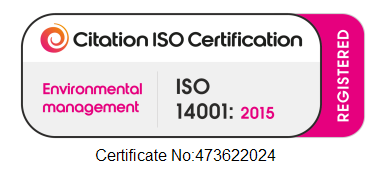Promotional Products from Recycled Plastic - Some Facts
The world has enough plastic, and we want to help keep it that way.

Recycling plastics is at the forefront of the battle to prevent the current 8 million tonnes of plastic entering the Earth’s oceans per annum. Unless plastics are created with additives which can help in biodegrading, they will take around 500 years to breakdown. Putting additives into plastic is not a ‘silver bullet’ because it creates some issues with the other properties of the plastic which can render them unusable - more on that below.
Types of Plastic
In principle all plastics can be recycled however the chemical composition of the various plastics make some considerably easier than others. As consumers we are familiar with the recycled sign in most plastics as follows:

PET - polyethylene terephthalate
Water bottles, soft drink bottles, pots, tubs, over ready trays, jam jars.HDPE - high density polyethylene
Chemical drums, Jerry cans, carboys, toys, picnic ware, household and kitchenware, cable insulation, carrier bags and food wrapping material.PVC - polyvinyl chloride
Window frames, drainage pipe, water service pipe, medical devices, blood storage bags, cable and wire insulation, resilient flooring, roofing membranes, stationery, automotive interiors and seat coverings, fashion and footwear, packaging, cling film, credit cards, synthetic leather and other coated fabrics.
LDPE -low density polyethylene
Squeeze bottles, toys, carrier bags, high frequency insulation, chemical tank linings, heavy duty sacks, general packaging, gas and water pipes.
PP - polypropylene
Buckets, crates, toys, medical components, washing machine drums, bottle caps, and battery cases.PS - polystyrene
Toys and novelties, rigid packaging, refrigerator trays and boxes, cosmetic packs and costume jewellery.
Separation of Post Consumer Waste
Most plastic re-cyclers do not rely on the Code (shown above) now; they use various sorting systems to identify the resin, ranging from manual sorting and picking of plastic materials to mechanised automation processes that involve shredding, sieving, separation by rates of density i.e. air, liquid, and complex spectrophotometric distribution technologies. Some plastic products are also separated by colour before they are recycled.
The plastic recyclables are then shredded. These shredded fragments then undergo processes to eliminate impurities like paper labels. This material is melted and either extruded into the form of pellets (PP and LDPE) or spun to create fibre as in the case of PET which are then used to manufacture other products.
The products that are sold within the promotional products industry are either the rigid Frisbee or ice scraper type made from LDPE or the spun fibre of PET.
Recycling Methods
Currently, plastics being recycled by either one of the two ways:
- Mechanical recycling – This involves mechanically treating the waste (e.g. grinding) to reduce it into smaller particles. The resulting granules, called re-cyclate, can be melted and re-moulded into different products, usually the same product from which it came.
- Feedstock recycling – Chemical processes such as pyrolysis, hydrolysis and heating are used to convert the waste into its chemical components. The resulting products – sodium chloride, calcium chloride, hydrocarbon oil products and heavy metals to name a few – are used to produce feed for other manufacturing processes or as fuel for energy recovery.
Clearly for promotional products we are talking about mechanical recycling of the plastic back into similar products. This is fine for the HDPE, PP and indeed for spun PET but can be an issue for PVC. PVC products, depending on their application, contain different additives. For example, rigid PVC is unplasticised whereas flexible PVC is added plasticisers because this additive increases the plastic’s fluidity and thus, its flexibility. Even products used for the same application may still differ in composition if they have different manufacturers.
PET Recling
The main use for PET is for carbonated drinks bottles and one use for this recycled PET is to create fabrics.
The fabrics are created by spinning the PET flakes into thread and yarn. This is done just as easily as creating polyester from brand new PET. The recycled PET thread or yarn can be used either alone or together with other fibres to create a very wide variety of fabrics. Traditionally these fabrics are used to create strong, durable, rough products, such as jackets, coats, shoes, bags, hats, and accessories since they are usually too rough for direct skin contact and can cause irritation. However, recent developments in technology have improved these types of fabrics under environmental pressure.
There is now a range of polyester t-shirts made from recycled PET including product from Under Armour. Polyester has fantastic wicking properties which makes it ideal for high performance sportswear.
Some Key Recycling Statistics
It is common to see plastics as a story of doom and gloom – but in truth recycling is making real progress. In 2000 some 13,000 tonnes of plastic bottles were recycled – the rate in 2018 was 350,000 tonnes.
Other key statistics:
- 74% of plastic drinks bottles are recycled.
- 46% of all plastic packaging is recycled.
- 31% of all plastic is recycled (this is a European figure).
Sources
Environment Agency, National Packaging Waste Database: https://npwd.environment-agency.gov.uk/Public/PublicSummaryData.aspx accessed 14.09.2018
PlasticsEurope, 2018 Plastics the Facts 2018:
https://www.plasticseurope.org/application/files/6315/4510/9658/Plastics_the_facts_2018_AF_web.pdf
Valpak Databite No3: https://www.valpak.co.uk/docs/default-source/information-zone/databite-no-3---drinks-container-recycling-rates.pdf
Also seek out the Plastic Federation website at https://www.bpf.co.uk/sustainability





